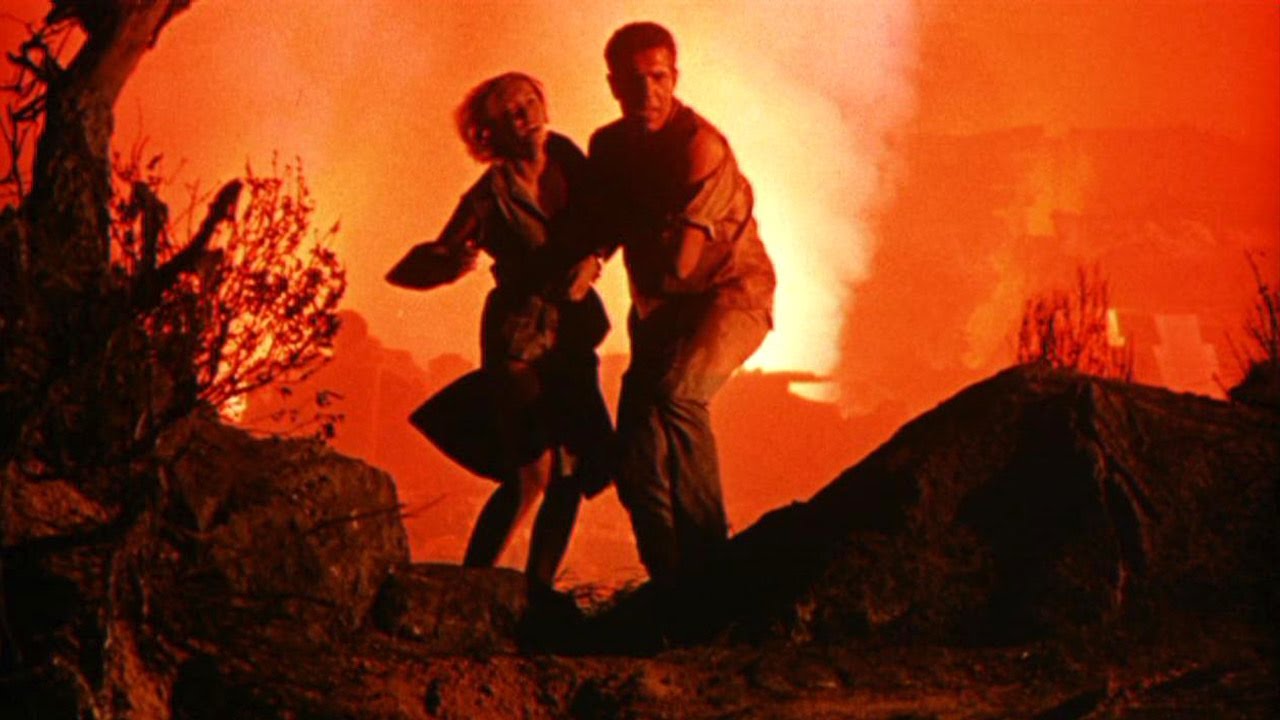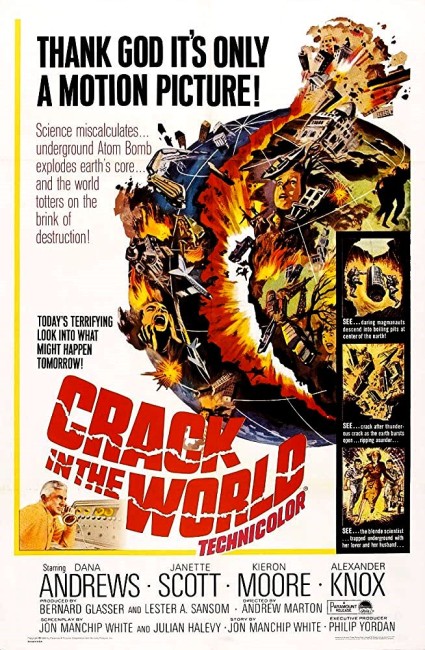USA. 1965.
Crew
Director – Andrew Marton, Screenplay – Julian Halevy & Jon Manchip White, Story – Jon Manchip White, Producers – Bernard Glasser & Lester A. Sansom, Photography – Manuel Berenguer, Music – John Douglas, Special Effects Director/Art Direction – Eugene Lourie. Production Company – Security Pictures, Inc..
Cast
Dana Andrews (Dr Stephen Sorenson), Kieron Moore (Dr Ted Rampion), Janette Scott (Maggie Sorenson), Alexander Knox (Sir Charles Eggleston), Peter Damon (John Macefield), Alfred Brown (Dr Bill Evans), Mike Steen (Steele)
Plot
An international team arrives in Tanganyika to assess Project Inner Space. The project’s head Dr Stephen Sorenson explains the plan to drill down to the Earth’s molten core in order to tap it as an unlimited supply of energy. The only drawback to the plan is breaking through the inner crust, which is so far proving impervious. Sorenson wants to use an atomic bomb to break through. His colleague Ted Rampion argues that underground atomic testing has weakened the Earth’s crust and employing an atomic weapon will trigger a series of catastrophic earthquakes, although Sorenson emphasises that this scenario is unlikely. The committee gives him the go ahead to fire the atomic warhead. However, immediately after the detonation, they receive seismological reports of a string of earthquakes that start travelling in a line around the world. With Sorenson falling ill with a condition he has hidden from everyone including his wife, Rampion races to stop the earthquakes before they bring about the end of the world.
Crack in the World is an End of the World film from back in the day before people discovered the disaster movie, which came along a few years later with massive box-office successes like Airport (1970), The Poseidon Adventure (1972) and The Towering Inferno (1974). It comes from a duo of producers who were active in making war films and other proto-disaster movie spectacles of the era such as Krakatoa – East of Java (1966).
As with many science-fiction films of the era, Crack in the World gives over much time to the clean and shining control room of the operation – this is a film that is proud to be part of the excitement that greeted the new technology of the dawning Space Age. It is worth comparing how two decades earlier Dana Andrews would be a mad scientist whose reckless and crazed experiments would have endangered the world and he would be made to pay for this at the end. Here he is merely an engineer and is seen as having forgivably miscalculated the outcome of a scientific experiment. (Even today he would almost certainly be vilified for bringing about the end of the world, showing just how far the redemption of the scientist had come between the 1940s and 1960s).
The science itself is somewhat dubious – like the idea that earthquakes would split part of the Earth’s crust off into orbit as a new moon (a very unlikely scenario in terms of gravity) without the people standing within viewing range being incinerated, let alone devastated by the massively catastrophic earth eruptions that would ensue. The silliest piece of science though is the idea that pockets of hydrogen trapped underground can suddenly turn into hydrogen bombs.

The science and spectacle is interspersed with human drama that is given more time and prominence than usual – with the writing in of a triangle between dying but hard-headed project head Dana Andrews who is covering up his terminal illness, wife Janette Scott and her ex Kieron Moore. This plays out fairly stolidly.
The difference between Crack in the World and subsequent CGI disaster movies – you might look to the somewhat similar The Core (2003) or the various cheap disaster movies that crowd out the Syfy Channel as a good example – is that Crack in the World has not quite yet hit on the idea of creating self-contained pieces of spectacle to intersperse with the control room talk. Thus the big drama only rarely directly involves the central characters. There is one good scene where Kieron Moore must descend down into an active volcano to plant a bomb, which generates some reasonable and effective drama, especially when things start going wrong.
Towards the end, the film starts to discover the idea of these pieces of self-contained drama, in particular with a scene where Kieron Moore and Janette Scott race to warn the people aboard a train that it is heading into the path of an eruption and we then see the train collapsing over a ravine. The film ends on a dramatic scene where the trio are caught in a collapsing control room and finally make it out onto a burning plain to see the new moon born out of the lava.
Director Andrew Marton was an emigre from Hungary who had worked as a director there since the silent era. In Hollywood, he gained fame as a second-unit director on films such as Ben Hur (1959) and Cleopatra (1963). He made a number of English-language films, mostly in the adventure category, the most well-known of which was King Solomon’s Mines (1950). In the 1960s, Marton began working on various Ivan Tors tv shows and directed several Tors-produced films, including two other science-fiction entries with Around the World Under the Sea (1966) and the comedy Birds Do It (1966).
Trailer here


